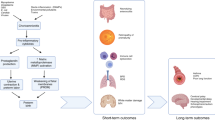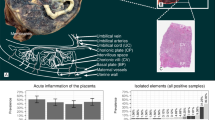Abstract
Acute chorioamnionitis comprises acute inflammation of the chorionic plate of the placenta, the amniochorial membrane and the umbilical cord. Most cases are the result of acute bacterial infection of the amniotic fluid/amniotic cavity, with the potential to spread to the fetus to initiate preterm labour or to cause maternal sepsis.
In the amniochorial membrane, the inflammatory response is of maternal origin. By histological examination the inflammatory response can show a range of extent and severity, which should be recorded in the histology report, either descriptively or as a grade and stage.
Access this chapter
Tax calculation will be finalised at checkout
Purchases are for personal use only
Similar content being viewed by others
References
Romero R, Chaiworapongsa T, Espinoza J. Micronutrients and intrauterine infection, preterm birth and the fetal inflammatory response syndrome. J Nutr. 2003;133:1668S–73S.
Kim CJ, Romero R, Chaemsaithong P, et al. Acute chorioamnionitis and funisitis: definition, pathologic features, and clinical significance. Am J Obstet Gynecol. 2015;213:S29–52.
Kraus FT, Redline RW, Gersell DJ, et al. Placental pathology. Washington, DC: Armed Forces Institute of Pathology; 2004. p. 75–115.
Rogers B, Abramowsky C. Chapter 2: Placental examination. In: Cohen MC, Scheimberg I, editors. The pediatric and perinatal autopsy manual. Cambridge: Cambridge University Press; 2014. p. 17–46.
Lee SM, Romero R, Lee KA, et al. The frequency and risk factors of funisitis and histologic chorioamnionitis in pregnant women at term who delivered after the spontaneous onset of labor. J Matern Fetal Neonatal Med. 2011;24:37–42.
Redline RW, Faye-Petersen O, Heller D, Qureshi F, Savell V, Vogler C. Amniotic infection syndrome: nosology and reproducibility of placental reaction patterns. Pediatr Dev Pathol. 2003;6:435–48.
Roberts DJ, Celi AL, Riley LE, et al. Acute histologic chorioamnionitis at term: nearly always noninfectious. PLoS One. 2012;7:e31819.
Cohen-Cline HN, Kahn TR, Hutter CM. A population-based study of the risk of repeat clinical chorioamnionitis in Washington State, 1989–2008. Am J Obstet Gynecol. 2012;207:473.el–7.
Yancey MK, Duff P, Clark P, et al. Peripartum infection associated with vaginal group B streptococcal colonization. Obstet Gynecol. 1994;84:816–9.
Soper DE, Mayhall CG, Froggatt JW. Characterization and control of intraamniotic infection in an urban teaching hospital. Am J Obstet Gynecol. 1996;175:304–10.
Newton ER, Piper J, Peairs W. Bacterial vaginosis and intraamniotic infection. Am J Obstet Gynecol. 1997;176:672–7.
Seaward PG, Hannah ME, Myhr TL, et al. International multicentre term prelabor rupture of membranes study: evaluation of predictors of clinical chorioamnionitis and postpartum fever in patients with prelabor rupture of membranes at term. Am J Obstet Gynecol. 1997;177:1024–9.
Rickert VI, Wiemann CM, Hankins GD, McKee JM, Berenson AB. Prevalence and risk factors of chorioamnionitis among adolescents. Obstet Gynecol. 1998;92:254–7.
Tran SH, Caughey AB, Musci TJ. Meconium-stained amniotic fluid is associated with puerperal infections. Am J Obstet Gynecol. 2003;189:746–50.
Galask RP, Varner MW, Petzold CR, Wilbur SL. Bacterial attachment to the chorioamniotic membranes. Am J Obstet Gynecol. 1984;148:915–28.
Heller DS, Moorehouse-Moore C, Skurnick J, Baergen RN. Second-trimester pregnancy loss at an urban hospital. Infect Dis Obstet Gynecol. 2003;11:117–22.
Lee SE, Romero R, Park CW, Jun JK, Yoon BH. The frequency and significance of intraamniotic inflammation in patients with cervical insufficiency. Am J Obstet Gynecol. 2008;198:633.e1–8.
Grigsby PL, Novy MJ, Adams Waldorf KM, Sadowsky DW, Gravett MC. Choriodecidual inflammation: a harbinger of the preterm labor syndrome. Reprod Sci. 2010;17:85–94.
Hagberg H, Wennerholm UB, Sävman K. Sequelae of chorioamnionitis. Curr Opin Infect Dis. 2002;15:301–6.
Khong TY, Mooney EE, Ariel I, et al. Sampling and definitions of placental lesions: Amsterdam Placental Workshop Group Consensus Statement. Arch Pathol Lab Med. 2016;140:698–713.
Ducey J, Owen A, Coombs R, Cohen M. Vasculitis as part of the fetal response to acute chorioamnionitis likely plays a role in the development of necrotizing enterocolitis and spontaneous intestinal perforation in premature neonates. Eur J Pediatr Surg. 2015;3:284–91.
Redline RW. Placental inflammation. Semin Neonatol. 2004;9:265–74.
Schrag SJ, Verani JR. Intrapartum antibiotic prophylaxis for the prevention of perinatal group B streptococcal disease: experience in the United States and implications for a potential group B streptococcal vaccine. Vaccine. 2013;31S:D20–6.
Bienenfeld S, Rodriguez-Riesco LG, Heyborn K. Avoiding inadequate intrapartum antibiotic prophylaxis for Group B Streptococci. Obstet Gynecol. 2016;128:598–603.
Author information
Authors and Affiliations
Corresponding author
Editor information
Editors and Affiliations
Rights and permissions
Copyright information
© 2019 Springer Nature Switzerland AG
About this chapter
Cite this chapter
Cox, P., Cohen, M.C., Scheimberg, I.B. (2019). Acute Inflammation. In: Khong, T., Mooney, E., Nikkels, P., Morgan, T., Gordijn, S. (eds) Pathology of the Placenta. Springer, Cham. https://doi.org/10.1007/978-3-319-97214-5_44
Download citation
DOI: https://doi.org/10.1007/978-3-319-97214-5_44
Published:
Publisher Name: Springer, Cham
Print ISBN: 978-3-319-97213-8
Online ISBN: 978-3-319-97214-5
eBook Packages: MedicineMedicine (R0)




